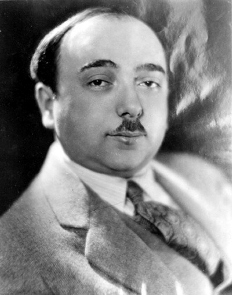
|
|


"It would take a Russian to invent it," an admirer of John Wenger once said, "because of their history" and their sensitivity to "the mystical qualities and intensity of light and color." He was, of course referring to John Wenger's painterly innovation of the skrim, a gauze-like drop used in theatrical stage design, a device for which Wenger became famous. Born June 16, 1887 in Elizabethgrad, Russia, Wenger's artistic skills developed as a child while he served as an apprentice to his father, a local artisan who painted scenery for traveling theatre companies. Wenger won a scholarship to the Imperial Art Academy in Odessa where his creative abilities flourished. Well known as a water-colorist, Wenger has achieved as much acclaim for his portraits as he has for his landscapes, still lifes, and set designs. In all of his paintings there exists a strong spiritual element, revealing the deeper subject of his work. His adventurous nature brought him to America in 1903, where he continued his studies at Cooper Union and the National Academy of Design. In New York, theatre and music became powerful muses for Wenger. He translated his sensibilities as a fine artist to his work in the theatre, designing environments that were anachronistic to the literal hard-lined sets of his day. His extraordinary sense of color coupled with his perceptive use of light created a new language, a more abstract expression in the performing arts. These artistic concepts dramatically influenced a change in the aesthetic values of traditional stage design. His creations were evocative of a myriad of motifs and human emotions, always celebrating the spirit of the particular playwright, actor, dancer, or composer by whom they were inspired. He was called a "master colorist" and "creator of pictoral symphonies" beginning with his design for "Ile" by Eugene O'Neil in 1918. As art director of the Rivoli, Rialto, and later the Capitol Theatre, Wenger received acclaim for the imaginative productions which illustrated his artistic vision. In 1919 he was commissioned by the Metropolitan Opera to design the American premier of Stravinsky's "Petrushka." Among his most famous designs were his sets for Gershwin's "Funny Face" and "Rhapsody In Blue" and his extravagantly beautiful designs for the Ziegfeld Follies. Wenger was also renown for his invention of the laterally moving set, 75 of which he created for Hammerstein's "Good Boy." The diversified eye of Wenger is widely appreciated, his work having been exhibited internationally over the years, with his paintings represented in numerous art collections both public and private throughout the world. The small Trucial State of Sharjah honored Wenger in the company of other great American artists such as Whistler and Sergeant, by issuing a postage stamp featuring one of his paintings. In New York alone he has had 25 one man shows and his work has been exhibited at and is included in the collections of The Metropolitan Museum of Art, The Museum of Modern Art, The Brooklyn Museum, the Museum of the City of New York (Permanent Collection), and the Smithsonian Institution. Wenger was the recipient of the Bronze Medal at the Sesqui Centennial International Exposition, and an honoree of England's Royal Society for the Encouragement of Art. John Wenger's prolific career as a visual artist ended when he died at the age of 89 in 1976. His visionary contributions to the world of theatrical design, and his paintings, are the remnants of a luminary. His poetic expressions were born of imagination and "vividly projected upon canvas in living colors." In looking at his work one sees with joy, a profound spirituality, a striving in the darkness - through which Wenger sees light. This is the quality that makes his paintings "a dominant force in the art world today - its inspirational power." |
Links to more information about the artist |
Visits to this site |